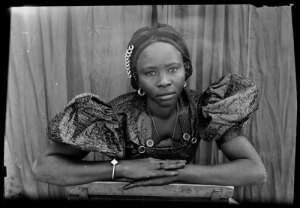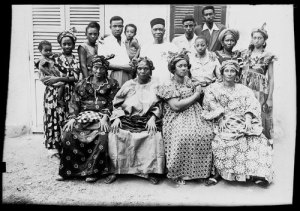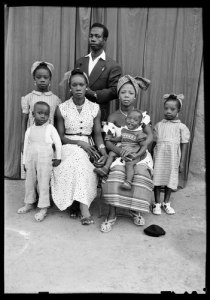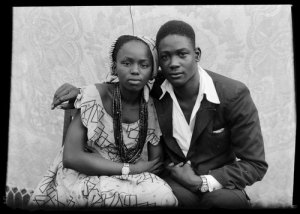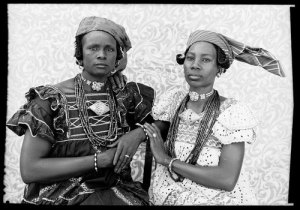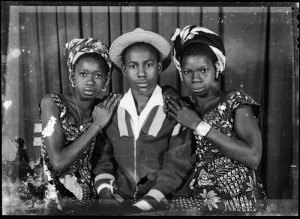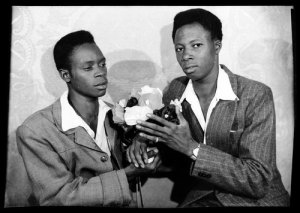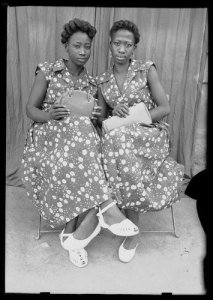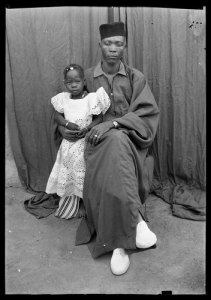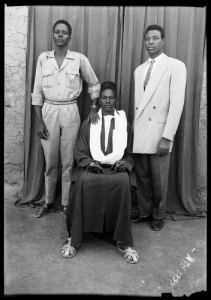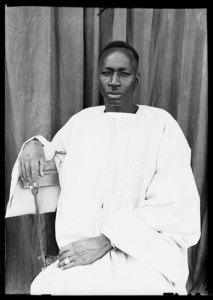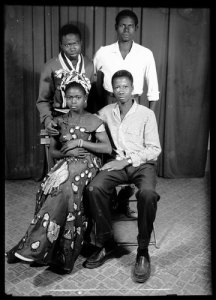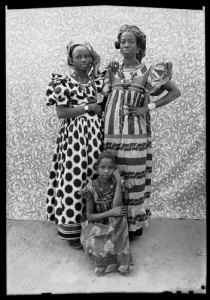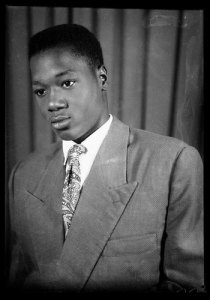A Conversation about the Work of Photographer Seydou Keïta
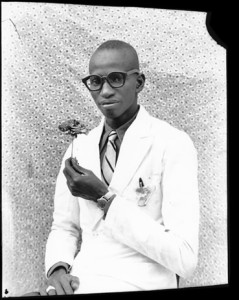 |
| Seydou Keïta 1921-2001 |
In May 2010, my niece Maya Caldwell graduated from UC Santa Cruz with a degree in history and the history of art and visual culture. I asked her about what had really interested her, and she sent me a paper she wrote on an African photographer, Seydou Keïta. I had never heard of him, but was interested in how an invention of the colonial world could be used by postcolonial Africans to define their contemporary times. What follows is my conversation with Maya about Keïta’s work.
Why are you interested in the use of photography in colonial Africa?
I was struck by the way that photography was used as a tool of colonization, particularly in French West Africa. The French maintained a presence on the Western coast of Africa from the 17th century onward, and by the 19th century they ventured inland in search of resources, battling the Muslim conquest empires that stood in their way. They began to take photographs of the native people that they encountered, which were then sold as postcards. Over 8,000 different postcards were produced in colonial West Africa from 1901 to 1963. Often these postcards were intended to document racial “types,” as the French called them, or illustrate the progress of French development projects. The postcards were sent mainly by European merchants and members of the French military. These postcards circulated throughout Europe, received by friends and families back home.
What do the thousands of postcards tell us?
The postcards reveal the way that the French colonizers viewed themselves and the people they were subjugating. Printed and handwritten captions on the postcards often highlight the racism inherent in the imagery. For example, one postcard of a bare-chested young woman carrying a bowl of water has a handwritten caption in French which translates as, “Young virgin. Very naïve.” Another has a typed caption that translates simply, “West Africa. Dioula Type.” When indigenous settlements are portrayed, they are made to look chaotic and dark in comparison to the light, linear, and orderly depictions of French buildings.
How did contemporary photographers change this dynamic?
In the 20th century, African photographers appropriated the colonizer’s aesthetic, using similar techniques and modified visual conventions to recapture the agency that had been taken from the previous generation of Africans by European colonists.
Beginning in the 1940s, Africans turned the colonizer’s tool on its head, using the photograph as a visual means of resistance. Early African photographers like Seydou Keïta and Mama Casset strongly influenced succeeding generations, including Malick Sidibe, Samuel Fosso, Philip Kwame Apagya, and many others.
Why did you focus your studies on Seydou Keïta?
Seydou Keïta (ca. 1921-2001) is a very well-known photographer today, both in Africa and internationally. Keïta is almost never mentioned without reference to the French collector André Magnin, yet the photographs that made Keïta famous were taken decades before his meeting with Magnin, in a small studio in Bamako, Mali. He was one of the first African photographers in Bamako. His studio was a business, and the photographs were taken of or for private clients to “put bread on the table.” They were not made as art objects. This is not to say that the photographs aren’t artistic. If there was one word for Keïta’s photographs, it would be captivating. The composition, the light, the pose, every detail is painstakingly perfected.
How did he get his first camera?
In 1935, when Seydou was around 14 years old, his uncle Tiemoko brought home a 6 x 9 Kodak Brownie camera from a trip to Senegal. Tiemoko explains that he didn’t originally intend to give it away, but Seydou was so fascinated by the contraption that Tiemoko gave it to him. Seydou’s father gave him some land behind the main prison in Bamako Koura, and that is where Keïta opened his studio in 1948. By then, he had over a decade’s experience taking photographs for his own enjoyment.
Can you explain applying the Foucault argument to Keïta’s subjects dressing like the colonizers?
In Keïta’s photographs, subjects often opted to wear western-style clothing and use props indicative of European influence, like radios, glasses, sewing machines, and cars. By displaying these symbols of “Frenchness,” the subjects may have felt that they were showing their advanced social and economic positions. The photographs seem to reflect a desire to partially assimilate, but they are also an assertion of control over that assimilation, and the degree to which it will take place.
Julie Doring, a scholar who has written about Keïta’s photos, drawing on the work of Foucault, argues that these photos reflect a kind of colonial ambivalence that “may ultimately empower the colonized.” Foucault suggested that appropriation could function as a means of empowerment. It may seem incongruous that after centuries of subjugation, African people would choose to don the accoutrements of the colonizer. These photographs represent a time and a feeling that cannot necessarily be categorized as one thing or the other, but I do think there are empowering elements in these photographs. They were taken by Africans of themselves, which in and of itself was a dramatic shift from colonial representation. The ability to imagine and create one’s own image is a very powerful thing.
How did the political turbulence in Mali impact Keïta’s work?
Seydou Keïta closed his studio in 1963, when he was asked to work exclusively for the new socialist government in Mali. Keïta says that he first got the job because he was related to the new president, Modibo Keïta. Throughout the turbulent political goings-on of the era, Seydou worked as an official government photographer. Despite his relation to Modibo Keïta, he stayed on under the Traore dictatorship. Keïta hints at political reasons for his departure, but does not elaborate, saying only, “Around that time, I had a misunderstanding with some of the military people, and I decided that I was tired of the job.” After he quietly retired from his government position, he worked as a mechanic.
Tell me about the meeting between André Magnin and Seydou Keïta.
The very first exhibition of Keïta’s photographs took place in New York in 1991 at the Center for African Art. They were part of a show called “Africa Explores: 20th Century African Art,” and the author was listed as “Unknown photographer, (Bamako, Mali.)” Curator Susan Vogel claimed that she had collected the photographs while on vacation in Mali and had neglected to save the name of the artist. Soon after the “Africa Explores” exhibition, André Magnin went to Mali to search for the artist at the request of collector Jean Pigozzi. The story of their meeting is told differently by Keïta and Magnin. The discrepancies between these two versions are full of significance. André Magnin, widely lauded as Keïta’s discoverer, paints a beautiful picture, describing Keïta’s Muslim garb, a boubou and fez, his pose in the doorway, the light in the window. Keïta, on the other hand, pokes fun at Magnin and his colleagues, claiming that they did not initially recognize him. Instead of being dressed up for the mosque, Keïta remembers that he was working on his engine. It is impossible to know what exchange actually took place that first day, but it is how they each remember the incident that underscores the controversy that later ensued.
What happened?
Whatever the real story of their meeting, Magnin and Keïta met and arranged a deal during Magnin’s visit to Bamako in 1991. Magnin selected 1,300 photographs to be enlarged and made into high-quality prints. The prints were sent to Keïta for signing, which verified the authenticity of the print and substantially increased the eventual price tag. The large sums of money at stake may have led to the discord that arose in the relationship between Magnin and Keïta. Apparently, their initial agreement had been a verbal one, as is customary in Africa. Towards the end of Keïta’s life, when it became clear that the artist’s health was failing, Magnin suggested to Keïta that he should entrust him with his estate. While specific details are hard to come by, it is clear that Magnin’s proposal upset Keïta. In October of 2001, just before his death, Keïta handed control of his estate over to his agent Jean Marc Patras, who helped him establish the Seydou Keïta Association in Bamako. The association eventually sued Magnin for the return of the negatives in his possession, but as of the latest media coverage, they have not been returned.
How do these images change when they move into the museum or gallery?
Since being featured in numerous museum and gallery shows, Keïta’s work has been the subject of some scholarly debate. Much of this debate centers around issues of authorship. At first, it seems obvious that Keïta is the author. After all, he took the photographs, he owned the negatives, he was (eventually) given artistic credit for the images. However, since these photos were created as a commercial product, the client had a collaborative role. Now, it is the viewer who collaborates with the finished product. When Keïta’s photographs are relocated to the museum or gallery context, they function differently. They are aesthetic objects available to the public for artistic interpretation and criticism, a use for which they were never intended. The audience often has little background on Keïta himself, and information about the subjects of photos, including their name, is usually nonexistent. In the museum or gallery setting, Keïta’s images take on new meanings, which may or may not reflect the intentions of Keïta and/or the subject.
Are they transformed from a commercial product into fine art?
I suppose it depends on how you define “commercial product” and “fine art.” Once again, there is no easy answer, and really it is up to the viewer to decide. One of Keïta’s most striking works is a photograph of a very large man dressed in a light-colored boubou, holding a tiny baby on his vast expanse of lap. The boubou is central to the image, and the man’s size only serves to underscore this focus. In addition, the size of the man and the size of the baby seem to play off of one another in a humorous way. The man’s good-natured smile shows that he is in on the joke. This man is one of the few clients whom Keïta remembered by name. Looking at this photograph during an interview, Keïta noted, “That big fellow there is Billaly.” Underneath this photo the name Billaly replaces what is usually the caption in the gallery or museum space. But while many of the works do not have names, the original subjects and viewers knew who they were. This is not the same kind of forced anonymity inscribed by colonial photographers. With Keïta’s photographs, it is only in the museum and gallery context that a name becomes a title or lack thereof. In the production of this image, Billaly was an integral part, and the image was made as an expression of his identity for personal use. In that sense, Keïta’s works are very different from works created for display in an institution. But does that mean they are not and should not be viewed as art in another context?
Are we participating in a kind of colonialism by promoting this work as art?
That is possible. It really depends on our perspective as viewers. What we create often has a life of its own that we cannot completely control. The viewer has the ability to place Keïta’s work in various contexts, and thus his work may take on a unique meaning for each individual viewer. I believe that it is also possible that through art we can promote understanding and develop something entirely new—that is not a kind of colonialism at all. The manifestation of that vision will require an ongoing global dialogue, which these questions are part of. By being displayed as art, Seydou Keïta’s work becomes a part of that dialogue. In any case, Seydou Keïta’s story is a testament to the power of images to both reflect and shape our perception of the world.
All photos courtesy seydoukeitaphotographer.com.
